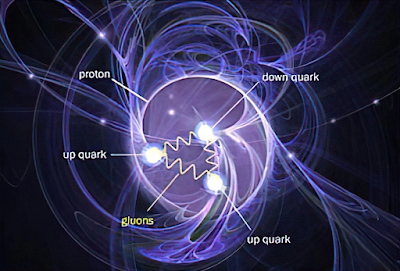"Quark and gluons inside a proton. Two up quarts, one down quark, gluons holding them together. Credit: Brookhaven National Laboratory." (ScitechDaily, Science Made Simple: What Are Protons?)
Proton: the particle that cannot decay.
The thing that makes protons so interesting is that they cannot decay. Or nobody saw that protons can decay. The complex inner structure of a proton is the reason why it exists longer than a neutron. The energy can travel to those pockets when it travels down quark to two up quarks. And that shares energy flow into the larger area than in neutrons. In neutrons, two down quarks transmit energy into one up quark.
That thing means that the up quark turns into the antenna that transmits energy into one point. And that energy breaks the shell of the neutron. The energy jumps from the quantum field between those three quarks and pushes them away.
The proton involves a more complex structure that can pull more energy into it than a neutron that has only three quarks. There are also antimatter-matter particle pairs in neutrons. There is some other particle between those particle pairs. And that denies the annihilation. But if something pulls the quantum field fast enough out that makes space between those particles.
Then those particle-antiparticle pairs could annihilate and that shockwave can destroy the proton. But as we know, nobody saw that happen. The fact is that the proton's internal structures expand when the proton expands. And that means the lifetime of the proton is very long. The proton is a particle that challenges the standard model.
Another thing that can challenge the standard model is B-meson.
Could there be some small, yet unknown hadron? Protons and neutrons are both hadrons. Their lifetime is different. The neutron decays in 15 seconds and the proton can last as long as the universe is. There is one interesting question: can hadrons form internal structures? Or can hadrons be inside other hadrons? The mesons are hadrons like protons and neutrons.
"In particle physics, a meson is a type of hadronic subatomic particle composed of an equal number of quarks and antiquarks, usually one of each, bound together by the strong interaction. Because mesons are composed of quark sub-particles, they have a meaningful physical size, a diameter of roughly one femtometre (10−15 m), which is about 0.6 times the size of a proton or neutron. All mesons are unstable, with the longest-lived lasting for only a few tenths of a nanosecond. Heavier mesons decay into lighter mesons and ultimately into stable electrons, neutrinos, and photons. (Wikipedia, mesons)
"In particle physics, a hadron is a composite subatomic particle made of two or more quarks held together by a strong interaction. They are analogous to molecules, which are held together by the electric force. Most of the mass of ordinary matter comes from two hadrons: the proton and the neutron, while most of the mass of the protons and neutrons is in turn due to the binding energy of their constituent quarks, due to the strong force." (Wikipedia, Hadron)
Normal particles decay into the same particles. Or there is a certain cycle. Or some other dominating actor like spin or energy level determines how those particles decay. And their decay productions.
W-bosons can decay to a lepton and antilepton (one of them charged and another neutral)[d] or to a quark and antiquark of complementary types (with opposite electric charges ±+1/3 and ∓+2/3). Those bosons are the transmitters of the weak nuclear force. (Wikipedia, W, and Z bosons)
As the authors of a brand new paper, published in late November of 2024 in Physical Review Letters, note, all of the decays that involve B-mesons decaying to either:
two pions,
two kaons,
or one pion and one kaon,
(Big Think, How B-mesons are threatening to break the Standard Model)
Kaons and pions are hadrons as well as protons and neutrons. The main question is: do those hadrons (muon and pion) form after the decay of the B-meson? Or do the bonds inside the B-meson cut in different places during the decay process because of some asymmetry? But is that asymmetry in energy or materials?
"B mesons are an important probe for exploring quantum chromodynamics. They consist of an antibottom quark paired with an up, down, or strange quark. B mesons decay via multiple pathways, several of which result in the production of π 𝜋 and K mesons. Measuring these rare branching fractions. Set limits on new particles." (https://physics.aps.org/articles/v17/s142)
The problem is that B-meson is not an elementary particle. The non-elementary particle should decay through particles that form it So the problem is that there should be something wrong if the decay productions are always different. In the case of B-mesons, the decay is similar to W-boson decay. And that thing means. That the B-meson acts like an elementary particle. There are theories that it's possible. That the hadrons can form internal structures.
The protons and neutrons are both hadrons. Hadrons are subatomic non-elementary particles. They act like elementary particles. There is a possibility, that some of those particles that we see as elementary are the hadron inside other hadron. And that means the standard model is the thing, that requires some actions like updating.
https://bigthink.com/hard-science/will-protons-last-forever-why-scientists-are-searching-for-signs-of-decay/
https://physics.aps.org/articles/v17/s142
https://www.quantamagazine.org/inside-the-proton-the-most-complicated-thing-imaginable-20221019/
https://scitechdaily.com/cracking-the-proton-code-unveiling-the-secrets-of-the-universes-building-blocks/
https://scitechdaily.com/ghostly-neutrinos-provide-groundbreaking-new-way-to-investigate-the-structure-of-protons/
https://scitechdaily.com/science-made-simple-what-are-protons/
https://en.wikipedia.org/wiki/B_meson
https://en.wikipedia.org/wiki/Hadron
https://en.wikipedia.org/wiki/Kaon
https://en.wikipedia.org/wiki/Meson
https://en.wikipedia.org/wiki/Neutron
https://en.wikipedia.org/wiki/Pion
https://en.wikipedia.org/wiki/Proton
https://en.wikipedia.org/wiki/W_and_Z_bosons#W_bosons_2
https://en.wikipedia.org/wiki/Standard_Model






















